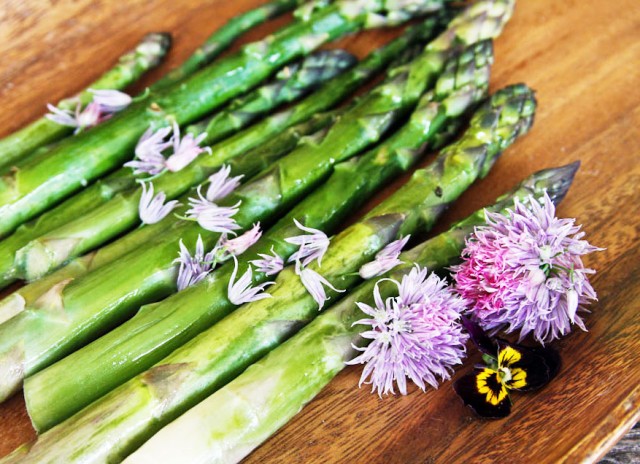1 bunch asparagus, tough stem ends removed
1 bunch chives, with flowers
1 tablespoon olive oil
Salt, to taste
Chive flowers, to garnish
Instructions:
To prepare asparagus, larger (thicker) stalks into coins. Smaller (thinner) stalks can be left as to be served as a side dish rather than mixed into rice. In a large sauté pan over medium-high heat, add olive oil. Add asparagus and quickly turn and toss until coated in oil. Add 1/2 cup water, or enough to cover the bottom of the pan. Briefly steam asparagus. Cook for no more than 2-3 minutes. Remove from pan with a slotted spoon when bright green and tender.
To serve, add coined asparagus to rice once prepared. Asparagus stems can be served separately as a side, with salt to taste. Garnish both with chive flowers.
For Broccoli Raab
1/4 pound broccoli raab
3 heads spring garlic
1-2 tablespoons extra virgin olive oil, to taste
Salt, to taste
Instructions:
Prepare garlic by mincing head and tender part of stem. Prepare broccoli raab by slicing to 3-4″ long pieces (or size desired). In a large sauté pan over medium high heat, warm olive oil. Add garlic and cook until just before tender; add broccoli raab and toss to coat with garlic and oil. Cook for 3 minutes, allowing to caramelize, then cover and slightly lower heat. If necessary to prevent burning, continue to toss or add a small amount of water and re-cover vegetables. Check for tenderness after 5-7 minutes. Drain water, then salt to taste.
For Rice
2 cups basmati rice
3 tablespoons coconut butter
Salt, to taste
Instructions:
In a pot with a lid, bring water to a boil. Add rice, bring to a boil, then simmer. Cook until tender, about twenty minutes. Once rice in moist and tender, add coconut butter, stirring in while in pot.
…
This light, healthy meal of broccoli raab and asparagus combines the best bitter and sweet flavors of a springtime garden. One of the worst crimes against asparagus is to overcook it, so be gentle on the produce. Instead, asparagus are best prepared in enough olive oil to ease out a caramelized note, then steamed quickly to brighten their greens and tenderize.
What appears to be scales on the asparagus tip are its flower buds. Asparagus is a perennial crop, returning each year as young shoots. The crop has a short harvest season: the plant’s priority is to make seeds and propagate. When the scales open up to flower, the plant’s slender eating form is irrevocably lost. When choosing asparagus, look for firm stems and buds tight and flush against the stem. To complete this dish, garnish with chives flowers rather than the chopped leaves. Chives, a cousin to onions, can be a little strong as a leafy herb, so a few scattered flowers add the flavor and bonus of subtle nectar sweetness.
Thankfully, springtime greens are usually milder flavored than their summer and fall counterparts. Traditionally, recipes celebrate bitter broccoli raab with garlic, or an acidic tomato-based sauce. This is a fine recipe idea for September, when tomatoes are harvested and the fall season broccoli raab crop is up. When available early in the year, cook with spring garlic. Juicy and in bulb form (rather than fully separated cloves), it cooks faster, allowing the broccoli raab to absorb its flavors without overcooking. Aromatic basmati rice and coconut add the sweetness needed to highlight, but not let the bitterness overwhelm, the dish.
Photo: Naima Green
About Annie Novak:
Annie is founder and director of Growing Chefs, field-to-fork food education program; the Assistant Manager of the Ruth Rea Howell Family Garden at the New York Botanical Gardens, and co-founder and farmer of Eagle Street Rooftop Farm in Greenpoint, Brooklyn in partnership with Goode Green and Broadway Stages.
